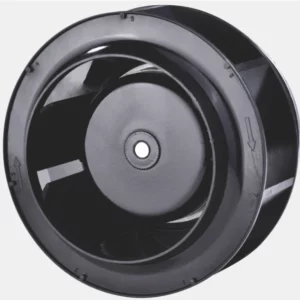EC centrifugal fans, also known as electronically commutated centrifugal fans, are a type of fan that utilizes a brushless DC motor technology to provide efficient and variable airflow. The operation of an EC centrifugal fan involves several key components and processes.
Here’s a general overview of how they work:
- Motor: The heart of an EC centrifugal fan is the electronically commutated motor, which is a brushless DC motor. Unlike traditional AC motors, EC motors are more efficient and can be controlled more precisely. The motor consists of a stator (fixed part) and a rotor (rotating part), and it is powered by direct current (DC).
- Control Electronics: EC fans incorporate control electronics, including a microprocessor and power electronics, to regulate the motor’s operation. These electronics receive input signals and adjust the motor’s speed and power consumption accordingly.
- Input Signals: EC fans can be controlled through various input signals, such as analog voltage, PWM (Pulse Width Modulation), or digital signals. These signals are typically provided by external devices like thermostats, sensors, or building management systems. The input signals determine the desired airflow or speed of the fan.
- Sensor Feedback: EC fans often have built-in sensors, such as temperature or airflow sensors, to provide feedback to the control electronics. These sensors help the fan adjust its speed and power consumption based on the actual operating conditions, optimizing energy efficiency and performance.
- Commutation: The control electronics of an EC fan use information from the sensors and input signals to determine the appropriate commutation sequence for the motor. Commutation refers to the switching of the motor’s current to different windings at specific times to generate rotational motion. The control electronics precisely control the timing and magnitude of the currents to achieve the desired motor speed and torque.
- Impeller and Centrifugal Action: The motor of an EC centrifugal fan is connected to an impeller, which is a series of blades or vanes. As the motor rotates the impeller, centrifugal force is generated, causing the air to move radially outward. This creates a pressure difference between the center and the outer edges of the impeller, resulting in the generation of airflow.
- Variable Speed Control: One of the significant advantages of EC centrifugal fans is their ability to vary the speed of the motor and airflow. By adjusting the input signals or control settings, the fan’s speed can be increased or decreased, allowing for precise control of ventilation or cooling requirements.
Advantages of ec centrifugal fan
EC centrifugal fans offer several advantages compared to traditional AC centrifugal fans.
Here are some of the key advantages:
- Energy efficiency: EC centrifugal fans are highly energy-efficient. The brushless DC motor technology used in EC fans allows for precise control of the motor speed, resulting in reduced power consumption. EC fans can adjust their speed based on the actual airflow requirements, eliminating the energy wastage associated with fixed-speed fans.
- Variable speed control: EC fans provide the flexibility of variable speed control. By adjusting the input signals or control settings, the fan speed can be easily increased or decreased to match the specific ventilation or cooling demands. This variable speed capability enables optimized airflow and energy savings, as the fan operates at the required level rather than constantly running at maximum speed.
- Quiet operation: The design of EC centrifugal fans often includes noise reduction features. The brushless DC motor technology contributes to quieter operation compared to conventional AC fans. Additionally, the ability to control the fan speed allows for further noise reduction by running the fan at lower speeds when higher airflow is not necessary.
- Longer lifespan: EC fans generally have a longer lifespan compared to AC fans. The absence of brushes in the brushless DC motor eliminates brush wear and reduces the risk of motor failure. The efficient motor operation also generates less heat, reducing the overall stress on the fan components and contributing to extended durability.
- Precise control and integration: EC fans can be easily integrated into automated control systems and building management systems. The use of input signals, such as analog voltage or digital signals, allows for precise control over the fan speed and airflow. This integration capability makes EC fans suitable for applications where airflow needs to be adjusted based on specific conditions or requirements.
- Reduced environmental impact: Due to their energy efficiency, EC centrifugal fans contribute to lower energy consumption and reduced greenhouse gas emissions. By using less power and optimizing airflow, they help in achieving energy-saving goals and promoting environmental sustainability.
Overall, the advantages of EC centrifugal fans include energy efficiency, variable speed control, quiet operation, longer lifespan, precise control and integration, and reduced environmental impact. These benefits make them an attractive choice for various applications, including HVAC systems, ventilation systems, data centers, and industrial processes.
